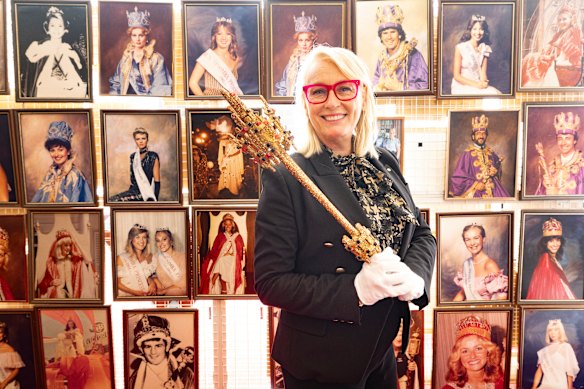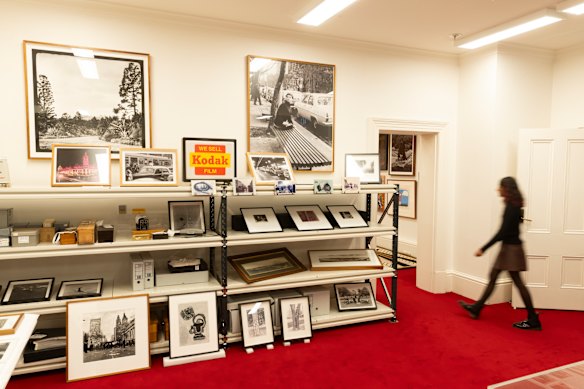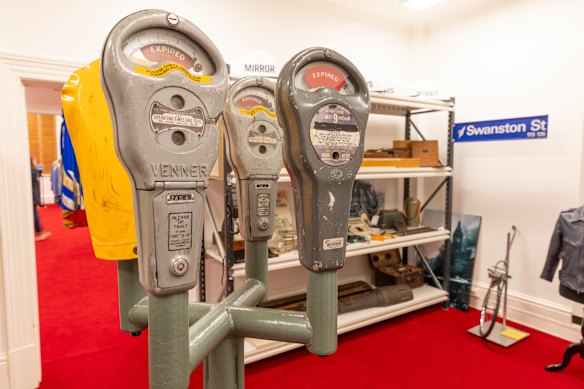Upstairs in Melbourne’s grand Town Hall, inside what was once a “rabbit warren of old offices”, lies a vast 13,000-piece treasure chest of the city’s history.
Here, the pompous ceremonial robes of lord mayors past share shelf space with gaudy Moomba costumes, gifts from visiting dignitaries, coin-operated parking meters and even models of the city’s humble former public urinals.

Former Melbourne lord mayor Sally Capp with a Moomba sceptre from the ’60s and portraits of Moomba monarchs.Credit: Jasn South
As part of this weekend’s Open House Melbourne, the public is invited to hear the stories behind these objects in a special talk by former lord mayor Sally Capp and the city’s long-serving curator, Eddie Butler-Bowdon.
Their free talk, Heritage Stories of the City, on Monday night at The Capitol will dive into the collection’s most fascinating tales.
Butler-Bowdon, who has overseen the collection for 22 years, calls it the “biggest and best capital city collection in Australia”. He says many Melburnians interact with it daily without realising it.
“It’s actually a problem that we faced over the years – it’s just incredibly hard to communicate that this [public artwork] – for example The Public Purse in Bourke Street Mall – is part of a much bigger thing.”

Part of the City of Melbourne’s art and heritage collection in Melbourne Town Hall.Credit: Jason South
The collection boasts one of the city’s biggest archives of Melbourne photography, documenting everything from iconic protests in the CBD to council-taken images of potholes.
It’s also a place of interactive research. “There’s the land use room, which is amazing,” said Capp. “If you live in the City of Melbourne ... you can go back and pick an address and go back through the books and see what’s been there before.”
The collection is constantly being added to with donations and acquisitions. Among the most recent additions is a donated briefcase of photographs taken by North Melbourne artist Viva Gibb, who died in 2017. Her work documents the streets and life of North Melbourne in the 1970s and ’80s.
Another recent addition is a 1971 painting of the former rail yards where Southern Cross Station now stands, by Michael Shannon, one of the first artists Butler-Bowdon says “considered the [Melbourne] industrial landscape as being worthy of documenting”.

Old parking meters and street signs are among the artefacts from decades past in Melbourne.Credit: Jason South
Capp instigated the collection’s move out of storage and into Town Hall during the pandemic, and has made accessibility a priority. The collection’s former home at 602 Little Bourke Street has since been transformed into the city’s Make Room, providing crisis accommodation for rough sleepers.
“For me, Town Hall is the people’s place,” Capp said. “It’s how we use [these objects], or what we did with them, or why we still admire them, that really says the story about who we are.”
It’s a sentiment echoed by Butler-Bowdon, who hopes the talk reminds people of the value of their shared past.
“Melbourne is a city in which heritage is really important to its soul,” he said. “And it’s the sort of thing that can disappear really quickly.”
The Heritage Stories of the City talk is part of Open House Melbourne. Free tours of the art and heritage collection run every 20 minutes from 10am on Sunday, as well as once daily on weekdays by booking.
Start the day with a summary of the day’s most important and interesting stories, analysis and insights. Sign up for our Morning Edition newsletter.